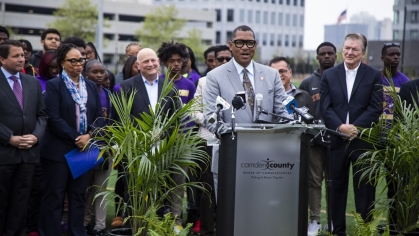New Jersey Residents Had a Rollercoaster 2020, Says New Study on Twitter Messages

For Rutgers University–Camden researchers, the messages are clear: 2020 was quite the emotional rollercoaster in New Jersey.
Over the past year, Dan Hart, a professor of childhood studies and psychology, and a senior vice chancellor; Sarah Allred, an associate professor of psychology; and Tory Mascuilli, a graduate psychology student, have tracked the emotional highs and lows of New Jersey’s counties by coding the content of residents’ Twitter messages.
“We learned a lot about the feelings of people across the state as 2020 unfolded,” says Hart.
Surprisingly, say the Rutgers–Camden researchers, New Jersey residents entered into the COVID-19 pandemic with optimism and hope. Early March, when New Jersey Gov. Phil Murphy announced that life in the Garden State would be transformed by the novel coronavirus, was actually a high point in tweets expressing positive emotion.
Then quickly came the low points. According to the researchers, as COVID-19 infected hundreds of thousands of New Jersey residents and killed nearly 20,000 of them, residents expressed some particularly unhappy moments on Twitter. Negative emotions peaked in mid-March, at the onset of the pandemic, with March 11 to 13 the unhappiest.

Sarah Allred
“On these dates, we learned that the pandemic was spreading and Gov. Murphy called for drastic actions to halt the disease,” says Hart.
New Jersey residents quickly adapted emotionally to the new realities of pandemic life – the extremes of mid-March were muted by the end of the month – but negative emotions expressed on Twitter were more common across the state than they were a year earlier.
As April and May ground on, hopes for the resolution of the pandemic diminished, and positive emotion expressed on the social media platform declined.
“Still, it’s worth remembering that New Jersey faced the pandemic with courage: concern for the challenge, anxiety and worry about the dangers, yet with some confidence that we’d overcome the challenges,” says Allred.
The murder of George Floyd on May 25 then unleashed powerful emotions throughout the country. A week later marked the second peak of negative emotions across New Jersey in 2020.
“Throughout the country, most Americans were angry that institutional racial injustice seems immutable,” says Hart. “Others were angry at the subsequent protests.”
There were also the high points. The Rutgers–Camden researchers explain that the pandemic had initially worn people down, with anxiety and depression increasing over the spring and summer. Slowly, however, New Jerseyans regained their emotional balance. December 2020 had the highest average for positive emotions expressed on Twitter since the pandemic began. Not surprisingly, they note, Christmas Day had the most positive emotions of the month.

Dan Hart
On the political front, the Rutgers–Camden researchers explain that the presidential campaign divided the country and New Jersey was no different. Throughout the spring and summer of 2020, tweets emanating from counties that voted for Biden were laced with references to conspiracies. In the days before the election, the polls revealed a consistent, countrywide preference for Biden, while conspiratorial thinking in Republican counties increased, perhaps as a result of President Donald Trump’s false claims that widespread voter fraud would be the only explanation for a Biden victory.
Conspiratorial reasoning then remained high in Republican counties through the end of the year.
“Because conspiratorial reasoning increases skepticism toward vaccination, we can anticipate that Republican counties in New Jersey may have lower rates of vaccination,” says Allred.
Among their other findings, the Rutgers–Camden researchers discovered that communities that were happiest in 2020 were the most affluent communities. Communities with high poverty rates were lowest in positive emotions expressed on the social media platform and highest in negative emotions.
“This is yet another reflection of the hardships experienced by those living in poor communities,” says Mascuilli.
They also found that the happiest days tend to be in the middle of the month. Negative emotions begin to rise toward the end of the month, and continue through the first few days at the beginning of the next month.
“This pattern is particularly evident in poor communities, perhaps signaling that family finances become stretched by the end of the month,” says Mascuilli.


